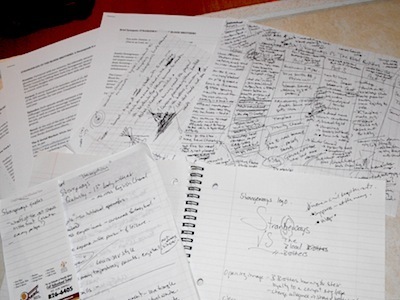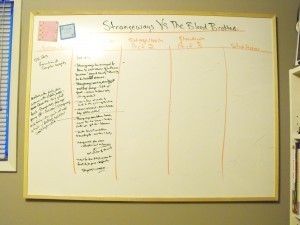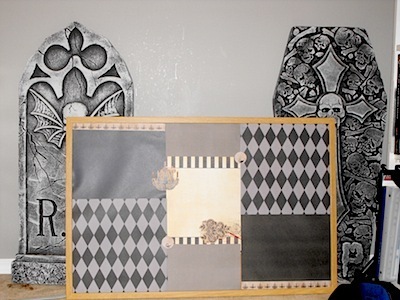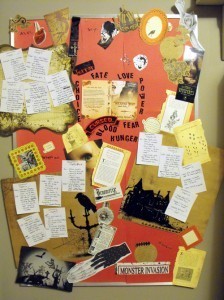For all you writing-craft junkies out there, I thought I'd do another post about storyboarding. My own definition has changed over the last year. Check out my original take here. Previously, I considered story boards as mere visual representations of the tale I was trying to tell. So, some photos, illos, graphics, mixed with my index cards plot notes. This method served me well, however, since expanding into screenwriting, I now have three separate uses for storyboards.
Brainstorming

I jot down as many ideas as possible, any and all plot twists, research implications and threads I can weave into my story. I let the story take me into multiple directions, get lost and discover dead ends, using the same structure of what will eventually be my whiteboard, but allowing myself to explore every angle before locking in. Through this process I'll filter out the lesser plot twists and (hopefully) leave the gold.
Plotting

When I have the major plot points narrowed down, it's time to take the story to the whiteboard. I'll divide it up into Teaser, Acts and Setup for the next book (as I usually write series fiction) and then subdivide each section with a more detailed list of scenes, each building to the next act/section. I've developed my whiteboarding structure from a blend of resources, but mainly from Blade Snyder's, Save the Cat! The Last Book On Screenwriting That You'll Ever Need. That's right, my plot structure for novels is the same as my structure for scripts.
Character Development
And now my visuals come into play. I grab a bulletin board, cover it a background appropriate to the genre and then plaster the thing with representations of my characters. Here's the board for Strangeways vs The Blood Brothers which I've just primed for action.

It will end up looking something like my board for Second Skin (below), although this time around I won't have plot notes – any text will be character traits / quirks. The board moves around the house with me, depending on where I'm writing at the moment, and I will stare at it between sentences/paragraphs/pages, keeping those traits/quirks front and center so my characters stay consistent.

During the creation of this Triple Threat of storyboarding, I might start jotting down scenes, dialogue, etc. However, I don't "begin" the story – the real hunker down and write stage – until I've completed these three steps. So…am I a plot Nazi? Maybe, but with deadlines and a day job, I find this the best way to avoid large rewrites during the editing process and pretty much nailing the plot in the first draft.
Which leaves edits for fine-tuning my use of imagery, language and emotion.
 newest »
newest »
 newest »
newest »
 newest »
newest »
Thank you so much!
Meagan